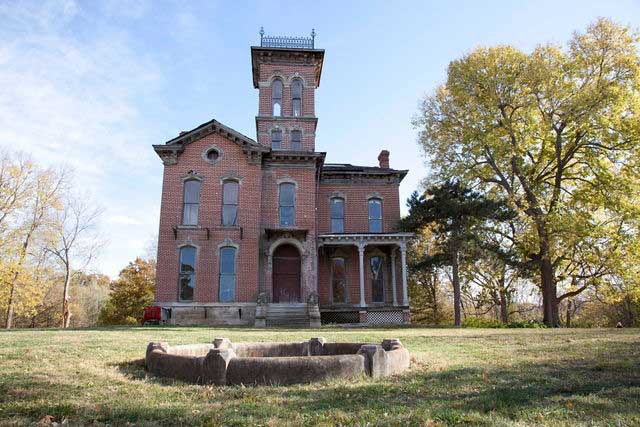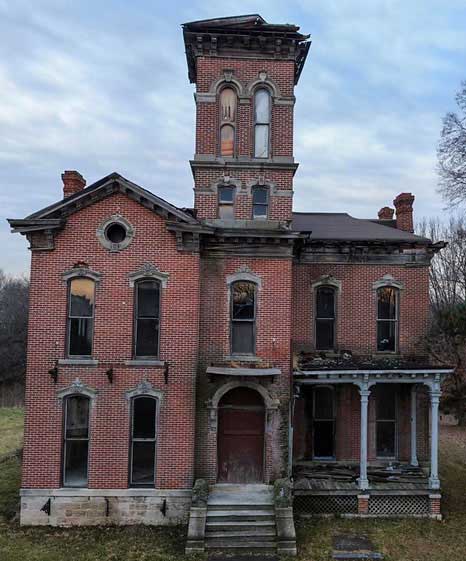November 2024
Michelle Knows Antiques
Italianate is not a new style of pasta
by Michelle Staley
Architectural salvage is a booming genre in the antique world. Architectural salvage is anything that is found in an old building or home from old wood floors to doorknobs. If an old building is slated to be demolished, a salvage company goes in and removes as much or as little as they can. Yes, there is a fee and a strict timeline.
Salvaging what is headed for the dump is the true definition of repurposing and recycling. Years ago near my house a warehouse club was being built and they bought three blocks of homes all were slated to be bulldozed. When we learned that the dossers were moving in, we loaded the truck with tools and went from house to house procuring a variety of items. I have several boxes of glass and stone doorknobs, a fireplace surround, enough bricks to build a walkway in the backyard, an exterior door with 40 panes of glass, several nice old wall sconces, and several other items. Needless to say we were not the only people out salvaging. One lady was digging up flowers and shrubs. My husband, ever the rule follower, sat in the truck until I mentioned the bricks.
As someone who has spent the majority of my life with antiques I often wonder about the life different pieces have lived, especially furniture. Who owned this item? What kind of house was it in? My family teases me about painted portraits I often buy. This brings up the question why is this portrait being sold.
The above is the lead-in to a huge win for the life of a castle. Sauer Castle at 935 Shawnee Rd in Kansas City, KS, is finally being brought back to life! I first encountered the beautiful home in the mid-1980s when an in-law got married up in the belvedere of the house. While the family was scattered about on the front lawn, heads thrown back watching the ceremony, I was scampering all over the inside. The building was still in good condition back then. The castle is near the home of one of my daughters, so every now and then I would drive by to check on it. Sadly, I saw the destruction and decay in real time.
Besides the age of 150 years, the style of Sauer Castle is beyond words. The Victorian/Edwardian era Queen Anne-style “Painted Lady” homes are stunning with the gingerbread trim and rounded corner towers. The pre-Civil War Antebellum homes based on the Greek Revival style are magnificent and their test of time adds to the allure. These are also referred to as plantation homes with the largest concentration being in Louisiana. Missouri has a little cluster of them in Weston. Yet my preference is for Italianate style buildings and that is what Sauer Castle is.
In my opinion, the Italianate style is one in which the best of all construction components have been put in to one style. The style is drawn from the Italian Renaissance period that was popular abroad and was intended to mimic the look of Italian cottages and villas. It became popular in America in the 1840s to 1890s.
Anton Sauer was born in Germany in 1823. He married and had a wife, but sadly she passed. In 1858 Anton moved to New York to be with his mother and sisters. His tuberculosis was worsening, so in 1868 he made the move to Kansas City. Sauer wanted to build a grand home on the highest spot in the area; he found such a spot on Shawnee Road on a bluff overlooking the Kansas River. The Shawnee Indian Trail, which was part of the Santa Fe Trail, passed right beside his home. Building began in 1871. It wasn’t long before he met and married a much younger widow, Mary (Maria) Einhellig Messerschmidt. Mary had two daughters. In 1872 the house was complete and fully furnished with furniture brought over from Europe. Anton and Mary went on to have five daughters. The property had a pool, a wonderful fountain in the front and several outbuildings, a wine cellar, bakery, and smoke house. I believe the remnants of a few are still somewhat standing.

Long shot of Sauer Castle showing the fountain.

Sauer Castle after years of neglect. (Images courtesy of the author)
Five generations of the Sauer family lived in the home before it began changing hands. With each successive owner the house fell into a greater state of disrepair. The two times great-grandson of Anton purchased the home with “the intent of restoring it.” Well, he was an absent landowner and the vandals took over. I spoke with the great-great-grandson several times offering my assistance in finding craftsmen to restore the home but to be honest he wasn’t interested it was more of an ego trip than anything. Finally the relative failed to pay the property tax and in 2023 Mr. Mike Heitmann purchased the property. In just a short period of time the transformation has been amazing. The slate roof was just completed about a month ago. It is expected to be open to the public in fall of 2025; believe me, I am counting down the months.
What makes an Italianate home so magnificent? It will have tall, narrow windows with an oval overhang at the top, overhanging eaves with large brackets; most have a belvedere on the top instead of a cupola, a belvedere is enclosed versus a cupola which is generally open. The belvedere at Sauer Castle is four stories tall and topped with a cast iron “fence” of sorts. A traditional Italianate building will have decorative molding at strategic places on the exterior with cast iron being very popular. Once you see a real Italianate building it will be forever burned into your brain.
If you are near or in the area please go by and see this gem emerging.
The home is on the National Trust for Historic Preservation, National Registry of Historic Places, the Registry of Historic Places, and the Registry of Historic Places in Kansas.
Photographs and Information Sources:
• visitkansascityks.com/sauer-castle
• National Trust for Historic Preservation
• savingplaces.org
• Wikipedia
• kcstudio.org
*All prices given are for sale in a private sale, antique shop, or other resale outlets. Price is also dependent upon the geographic area in which you are selling. Auction value, selling to a dealer or pawn shop prices are about ½ or less of resale value.
Michelle Staley is a Lenexa, KS-based dealer and researcher with 35 years of experience in the antique trade.
Send questions with photos to Michelle at michelle@discovervintage.com or TXSmichelle@gmail.com. Please keep queries to one question; questions without photos of the item may not be answered. There is no guarantee that your question will be answered or published.
Michelle is also available for consulting and extensive research work beyond this column. If you would like an appraisal on an antique or collectible please go to www.michellesantiqueappraisals.com for a one-on-one appraisal. Please note new web address.

